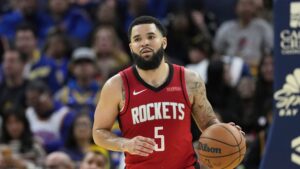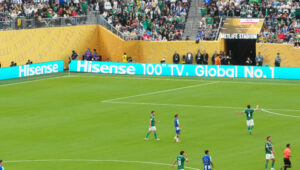NEW YORK – The towering 20-by-12-foot structure rises like a digital monolith inside Christie’s Woods Room, just steps from the historic auction house’s marble-clad lobby at Rockefeller Center in Manhattan, a space that has previously showcased icons such as Louise Bourgeois, Jean-Michel Basquiat and Andy Warhol.
If this is a place where artwork comes to life, its latest inhabitant functions as a digital portal, an immersive gateway that collapses time, fusing past and future in a cascade of visuals that feel ripped from The Matrix movies. This work bridges two worlds that have long existed apart: the tribal passion of soccer and the cerebral, curated realm of fine art.
The artist involved, Refik Anadol, will tell you plainly he wasn’t a fan of the sport that draws billions of people together around the globe.
As a boy growing up in Istanbul, he watched an occasional Beşiktaş derby against Galatasaray with his uncle, a diehard fan, but for the world-renowned media artist behind some of the most ambitious AI-driven installations of the last decade, football was always a backdrop rather than an obsession.
Until Lionel Messi.
Anadol knew who Messi was, but his interest was less in the global football icon who has won eight Ballons d’Or, the annual award given to the sport’s best player over the previous 12 months, but more in his impact on the world. “Messi the maestro”, as Anadol calls him. A once-in-a-generation talent whose brilliance on the pitch transcends sport and bleeds into something more elemental.
So when the charitable foundation of Inter Miami, the Major League Soccer club Messi now plays for, and Christie’s approached him – via curator Ximena Caminos – with an proposal to reimagine the Argentine’s choice as the most meaningful goal of his long and glittering career as a generative data sculpture, Anadol saw an opportunity.
“Art has always been an incredible catalyst to amplify messages that are relevant to this moment,” Caminos told The Athletic.
Anadol knew from the beginning that his job was not to document a goal from a sporting perspective, but to transform it into a living memory of a moment from thousands of different angles.

The Messi-inspired artwork is referred to as a “data sculpture and is the latest creation of artist Refik Anadol. (Refik Anadol Studio)
“This wasn’t about replaying the moment,” Anadol told The Athletic. “It was about reconstructing a memory, in this case his memory, through data, emotion and space.”
The result is a first-of-its-kind artwork titled ‘Living Memory Messi — A Goal in Life’, which will be auctioned at Christie’s New York at the end of this month for charity. The installation reimagines Messi’s header against Manchester United in the 2009 UEFA Champions League final, a moment the player himself selected as the most meaningful of his 800-plus goals.
“It’s hard to choose just one, there have been so many,” Messi told the crew who interviewed him a few months ago in an interview that has not been shared with the public until now. Out of all his goals, that second-half header which sealed Barcelona’s third European Cup/Champions League title stands out as a defining moment in his 21-year professional career.
“That goal is my favorite,” he smiled. “It was the most beautiful and unique, because it was a header (Messi, famously, is only 5ft 7in/170cm tall). I jumped really high, which is rare for me.”

Messi called the goal “beautiful and unique”. (Photo courtesy of Refik Anadol Studio)
Played on a balmy May evening in Rome’s Stadio Olimpico, the match was billed as a clash of titans: Pep Guardiola’s Barcelona, a team that was reshaping modern football with their slick, possession-based style, up against Sir Alex Ferguson’s Manchester United, one of the most successful and valuable clubs in the world, the defending European champions and still brimming with attacking firepower.
Messi was already a star in 2009. Then 22, he was fast and unmistakably gifted. But he was still in the process of evolving from prodigy to legend. The pressure was immense. He not only had to dazzle, but to deliver. The world was watching to see if La Pulga (The Flea, a reference to his size), the boy wonder, could rise under the spotlight and cement his name among the game’s immortals.
And he delivered.
In the 70th minute of the final, with Barcelona already leading 1–0, Xavi Hernández floated a precise, looping cross into United’s penalty area.
What happened next stunned even Messi’s most faithful fans.
The diminutive Argentine ghosted between defenders, leapt high behind 6ft 2in center back Rio Ferdinand and met the ball with a perfect header, looping it past goalkeeper Edwin van der Sar into the far corner of the net. It was Messi’s first headed goal of the season in his 51st appearance. He ran toward the corner flag, arms outstretched, grinning in disbelief.
🔵🔴 First Champions League goal back in 2005 for teenager Leo Messi! @FCBarcelona | #UCL pic.twitter.com/GA7fBjTn1k
— UEFA Champions League (@ChampionsLeague) August 10, 2021
“I did not overthink it, it just came to me naturally,” Messi explained. “I simply jumped, connected with the ball the way I always do and it turned into a goal.”
Messi’s feelings for this goal come across as a mixture of pride, fondness and perhaps a bit of disbelief. He does not dramatize it, but you can tell it holds deep personal meaning. It’s not just a beautiful goal, it is a rare moment that defied his usual style yet captured everything great about him: instinct, timing, precision and execution under pressure.

Messi selected his 2009 Champions League final header as his favorite goal of his entire career. (Refik Anadol Studio)
“I never thought it was the hardest goal I scored, it certainly was the most important and most memorable one,” he said.
That goal sealed Barcelona’s 2–0 victory, completing a historic first treble for the Catalan club, to go with winning the title and domestic cup back in Spain, and marking Messi’s arrival as a player who would go on to define an era.
“To me, that header is not just a goal,” Anadol said. “It’s a portal. A moment where a boy became a maestro.”
Over two decades, Messi has authored one of the most storied careers in the history of sport.
With Barcelona, he lifted four Champions League titles and 10 La Liga trophies, and broke the record for most Ballons d’Or wins. His rivalry with Cristiano Ronaldo of Barca’s biggest domestic competitors Real Madrid dominated global headlines for more than 10 years, while his singular style, low center of gravity and surgical left foot redefined what it meant to be a No 10 in this sport.
When Messi left Barcelona in 2021, due to financial constraints at the club, it marked the end of an era. Joining Paris Saint-Germain, he added more silverware, but it was his World Cup win with Argentina in 2022 that delivered the final validation for many, especially those in his homeland – a crowning achievement that elevated him beyond greatness.
Anadol’s challenge wasn’t simply to recreate Messi’s header, it was to transform it into something never seen before.
“Memory means something very different in this context,” he explained. “Every goal is a memory for him. But for Messi to choose the most meaningful one feels deeply significant.”
For Anadol, that’s Messi’s gift to this project: offering up this moment from his life to raise awareness and hopefully generate funding for something good.
“That connection really matters to me,” Anadol said. “And I think, in his mind, it does too.”
With his team of engineers and researchers, Anadol reconstructed the goal using footage from UEFA, European football’s governing body (which he points out is only two-dimensional), player tracking data and machine learning algorithms. From there, his team used machine learning and AI to reconstruct the moment in 3D, essentially bringing a 16-year-old memory into the present with technology that didn’t exist in 2009.
Every frame and every movement was rebuilt mathematically: the speed and trajectory of the ball, the positions and motions of every player, the fluid coordination of the team. It’s not just watching the goal, it’s AI rewatching it, filling in the gaps and analyzing the physics and decision-making embedded in those few seconds.

The goal was recreated in 3D (Refik Anadol Studio)
Beyond the data, Messi’s eight-minute interview reflecting on the goal, what he felt and why it mattered, was used to create the soundtrack.
“We analyzed his voice, facial expressions, and emotional cues to layer those feelings into the project,” Anadol explained. “The result isn’t just a digital artwork, it’s a data sculpture. Not bronze or marble, but a fully immersive, architectural-scale installation.”
Inside the installation — a mirrored, immersive room — the lines between viewer, data and memory blur. Visitors become part of the piece, surrounded by a living, breathing sculpture of movement, light and sound. Stadium noise echoes. Commentary loops. Messi’s own heartbeat mixes with ambient audio to create what Anadol calls a “memory soundscape”.
“When you walk in, it feels like stepping into Messi’s memory — part sculpture, part science-fiction,” he said. “The space becomes a canvas, and the architecture itself transforms into a living painting, textured with Messi’s emotions and layered with data. It’s a completely new kind of storytelling.”
For Anadol, whose past works have ranged from Alzheimer’s awareness installations to partnerships with NASA and SpaceX, the project marks a fresh kind of collaboration — one between two masters of completely different mediums.

The images are accompanied by sights and sounds from an exclusive Messi interview. (Refik Anadol Studio)
“I don’t see Messi as an artist,” he said. “I see him as a maestro. He orchestrates space and time in ways that defy logic. I paint with data. He paints with motion.”
As the first edition of FIFA’s expanded version of the Club World Cup wraps up in the New York area with the final between Chelsea and Paris Saint-Germain on Sunday, ‘The Greatest Goal’ has arrived at the perfect time. A year from now, the World Cup final will be played there at MetLife Stadium in New Jersey, too.
Until July 22, the artwork will be up for auction online by Christie’s, with 100 per cent of proceeds benefitting the Inter Miami Foundation over a range of charitable initiatives, including its partnership with UNICEF, which supports access to quality education programs in Argentina, Mexico, El Salvador, Honduras and Haiti.
The bids were to start at $1.5million (£1.1m), but Anadol hopes the sculpture won’t disappear into private hands.
“This isn’t just a collaboration between two people, it’s a dialogue between two disciplines,” he said. “It’s not artist meets artist; it’s sport meets art. And that’s what makes it so fresh and powerful.”
(Top photo: Filippo Monteforte / AFP / Getty Images)



